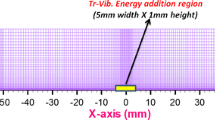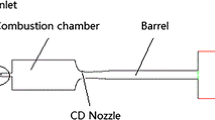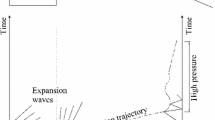Abstract
A computational fluid dynamics (CFD) simulation for analyzing fluid flow patterns in a plasma spray gun is presented in this study. It is coupled with a heat transfer simulation of the plasma spray gun. Based on CFD and heat transfer theory, the numerical model of the nozzle in the plasma spray gun is developed, and the coupled simulation of the flow fluid and heat transfer is carried out with the semi-implicit method for pressure-linked equations (SIMPLE) method. Local turbulence, which will lead to appearance of a static-water region, is found at the front corner of the cooling channel in the nozzle. The locations insufficiently cooled are found in the wall near the heat source and in the gasket in the rear of the nozzle. Then, cooling processes with different parameters of cooling water are analyzed. The optimal velocity and direction of cooling water, which efficiently cool the nozzle and improve the service life of the plasma jet, are obtained .
Similar content being viewed by others
References
Kitaguchi S, Takeshima Y, Nishisaka T, et al. (1990) Japan Soc Powder Powder Metall 37:918–921
Azevedo LFA, Sparrow EM (1985) Natural convection in open-ended inclined channels. ASME J Heat Transf 107:893–901
Chen TS, Tzuoo KL (1982) Vortex instability of free convection flow over horizontal and inclined surfaces. ASME J Heat Transf 104 (4):637–643
Wang S (1994) The basic numerical research of flowing of cooling water in the engines. Transaction CSICE 1994(12):57–63
Wang S (2001) Optimal design for the blades of turbo chaser by genetic algorithms. J Armored Force Eng Inst 2001(3):81–84
Meuber HJ, Spiegel L, Ganser J (1995) Particle tracking velocimetry – a powerful tool to shape the in-cylinder flow of modern multi-valve engine concepts. SAE paper 950102
Moss JA, Ngoyen TV (1997) Evaluation of altitude compensating nozzle concepts for RLV. AIAA 97-3222
Margany R, Nino Z, Vafidic L (1990) The effect of intake duct length on the in-cylinder air motored in a motored diesel erngine. SAE paper 900057
Zhang H, Wang G, Luo Y, Nakaga T (2001) Rapid hard tooling by plasma spraying for injection molding and sheet metal forming. Thin Solid Films 390(1–2):7–12
Bae JN, Bae KY (1987) A study on the heat flow in the arc-spraying process. Surf Coat Technol 31:273–288
Joshi SV, Sivakumar R (1993) An analytical approach to plasma spraying. In: Suryanarayanan R (ed) Plasma spraying: theory and applications. World Scientific, Singapore, pp 121–137
Cirolini S, Harding JH, Jacucci G (1991) Computer simulation of plasma-sprayed coatings I, coating deposition model. Surf Coat Technol 48:137–145
Author information
Authors and Affiliations
Corresponding author
Rights and permissions
About this article
Cite this article
Wang, W., Li, D., Hu, J. et al. Numerical simulation of fluid flow and heat transfer in a plasma spray gun. Int J Adv Manuf Technol 26, 537–543 (2005). https://doi.org/10.1007/s00170-004-2334-x
Received:
Accepted:
Published:
Issue Date:
DOI: https://doi.org/10.1007/s00170-004-2334-x




